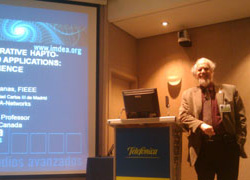IMDEA Networks

Event Category: In-house Presentation
Towards a Next Generation Internet Architecture
The international networking research community has begun to focus on ideas for a next generation Internet architecture. Before developing a next generation architecture, however, it seems appropriate to understand what exactly the problems are with the current Internet architecture. There seems to be widespread agreement that mobility and security are the primary problems stressing the current Internet, but exactly what the problems with mobility and security are, and in particular, whether the problems are architectural in nature, is under dispute. In this lecture series, we examined the mobility and security with the intention of understanding the current architecture and what might be done for a next generation architecture.
Read more arrow_right_alt"Research Trends in Future Internet”, Telefonica Open Research Day 2008
Telefonica Open Research Day 2008
Research is the process of exploration of new ideas and allows Telefonica to look into the future, working on tomorrow's problems and finding solutions that people can only dream about today.
As a result Telefonica is investing in bringing together incredibly passionate talented people with different view points (nationalities, disciplines, backgrounds) to follow their dreams, create new subjects and as a result new worlds for Telefonica's customers.
Read more arrow_right_altKey Issues of Peer-to-Peer Mechanisms as Future Internet Communications
Ralf Steinmetz is one of the world experts in multimedia and P2P applications, is the author of one of the most referenced books in the area, and he has received the ACM Multimedia Award.
Since early 1996 Ralf Steinmetz has been a professor at the dept. of Electrical Engineering and Information Technology as well as at the dept. of Computer Science of the Darmstadt University of Technology, Germany. There he is in charge of a chair position as managing director of the "Multimedia Communications Lab". From late 1996 until late 2001 he directed the GMD/Fraunhofer Integrated Publications and Information Institute. In 1999 he founded the Hessian Telemedia Technology Competence Center (httc e.V.). On whose board he has since served as chair. He is also one of the directors of the Information Transfer Office at the university. From 2002 to 2004 as dean he managed the department.
Read more arrow_right_altDistributed and Collaborative Hapto-Virtual Environments and Applications: Effects of Networking Impairments on Quality of Experience
Multimedia Communications, involving traditional media such as audio, video, text, 2D graphics, have become parts of everyday e-life. New digitalmedia, such as Virtual Reality and Haptics, have now added new dimensions to multimedia tele-collaboration. This presentation will introduce basic issues on Distributed and Collaborative Virtual Environments, where the feeling of touch (haptics) and its transmission over networks is becoming essential. Various applications will be described ranging from industrial training to e-commerce to medical education. Effects of networking =93quality of experience on collaborative hapto-virtual applications will be discussed and methods for delay and jitter compensation will be described.
Read more arrow_right_altSeminar-IP Autoconfiguration for Vehicular Networks
More information about Marco Gramaglia The seminar will be conducted in English
Read more arrow_right_altWhat do opportunism, data mining and coordination have to do with system-level optimization of wireless networks?
We present a system-level framework to mitigate interference using coarse grained coordination of transmissions across base stations. Our approach is based on collecting and mining measured data capturing a user population's diversity in sensitivity to interference. The talk introduces the abstractions and optimization framework we have devised to enable this type of coordination. The talk is in two parts addressing what we deem to be key areas of inquiry.
Read more arrow_right_altxIP - eXtending IPv4 address space
Instructor:
Lugar:
Fecha: 12th May, 2009, 10:00 – 11:00
Organización:
Read more arrow_right_alt
A Control Theoretic Framework for Performance Optimization of IEEE 802.11 Networks
More information about Paul Patras The seminar will be conducted in English
Read more arrow_right_altFrom Networking Research to Hapto-Virtual Multimedia Communications
Multimedia Communications, involving traditional “media” such as audio, video, text, 2D graphics, have become parts of everyday e-life. New digital media, such as Virtual Reality and Haptics, have now added new dimensions to multimedia tele-collaboration. This presentation will introduce basic issues on Distributed and Collaborative Virtual Environments, where the feeling of “touch” (haptics) and its transmission over networks is becoming essential. Various applications will be described ranging from industrial training to e-commerce to medical education, and the current research at the DISCOVER research lab, Univ. of Ottawa will be outlined.
Read more arrow_right_alt











Recent Comments